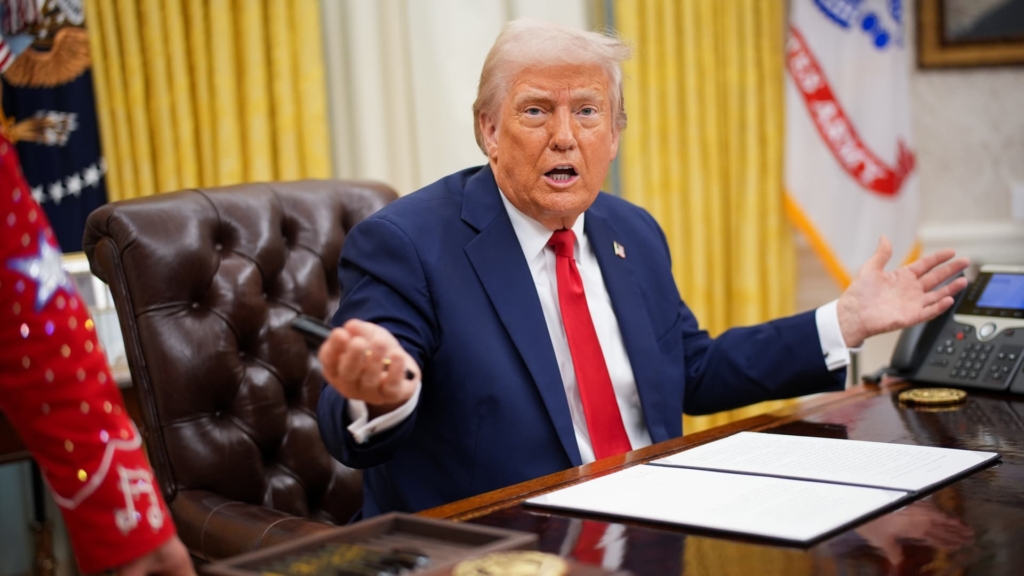On Wednesday, President Donald Trump is poised to initiate a significant step in his early second term, proposing widespread tariffs on imports that he hopes will revitalize the U.S. economy.
The implications of this decision are considerable.
With consumer confidence reaching multi-year lows, there is notable concern that the proposed tariffs could lead to further inflation. Investors are anxious that rising costs may decrease profits and complicate an already strained stock market.
The president’s vision is to cultivate an economy less reliant on deficit spending, aiming to prevent trading partners like Canada, Mexico, China, and Europe from exploiting American consumers’ preference for lower-priced goods.
However, clarity on executing these ambitious objectives remains elusive for those outside the administration.
Joseph LaVorgna, who previously served as a senior economic advisor during Trump’s first term, remarked, “People always want everything to be done immediately and have to know exactly what’s going on. Negotiations themselves don’t work that way. Good things take time.”
For LaVorgna, now chief economist at SMBC Nikko Securities, there is hope that Trump’s strategy can succeed. However, he acknowledges the markets’ jitters due to the prevailing uncertainty.
“This is a negotiation, and it needs to be judged in the fullness of time,” he noted. “Eventually, we’re going to get some details and some clarity, and to me, everything will fit together. But right now, we’re at that point where it’s just too soon to know exactly what the implementation is likely to look like.”
What is known is that the White House plans to introduce “reciprocal” tariffs on its trading partners. This strategy entails matching the tariffs imposed by other countries on U.S. goods. A 20% blanket tariff has been mentioned, although LaVorgna believes the actual figure will likely be around 10%, and possibly as high as 60% for imports from China.
As these tariffs develop, Trump aims to address a substantial trade deficit of $131.4 billion. His approach includes negotiating terms that would shift more manufacturing back to the U.S., enhancing domestic job opportunities and fostering fair trade practices.
Nevertheless, the near-term consequences may be challenging.
Potential inflation impact
Tariffs essentially serve as a tax on imported goods and could theoretically contribute to inflation. However, the real-world impact varies significantly.
During his initial term, Trump levied substantial tariffs without triggering widespread inflation, outside of certain price increases. Federal Reserve economists typically regard tariffs as a temporary “transitory” spike rather than a long-term inflation driver.
This situation, however, presents potentially unique challenges, akin to the catastrophic Smoot-Hawley tariffs of 1930, which incited a global trade war and could represent the most troubling aspect of the president’s strategy.
As Allianz chief economic advisor, Mohamed El-Erian, articulated on Finance Newso, “This could be a major rewiring of the domestic economy and of the global economy, akin to Thatcher or Reagan, where you create a more enabled private sector and a fair trading system. Alternatively, if we get into tit-for-tat tariffs, we risk sliding into stagflation, which could become problematic.”
Signs of a stagflation-like environment are already surfacing in the U.S. economy, characterized by slowing growth and persistent inflation, although not as severe as experienced in the 1970s and early ’80s.
Goldman Sachs has revised its 2025 growth forecast to near stagnation, attributing it to a decline in consumer and business confidence and the secondary effects of tariffs. Administration officials seem willing to accept short-term growth reductions to pursue their long-term trade objectives.
The Federal Reserve recently estimated a 1.7% growth in gross domestic product (GDP) for the year, while Goldman Sachs now projects a mere 1% growth rate.
Additionally, Goldman has increased the recession probability to 35% for this year, though it anticipates growth to remain positive in the most likely outcome.
Broader economic questions
Luke Tilley, Wilmington Trust’s chief economist, contends that the recession risk may be even higher, at 40%, driven not only by tariff effects.
“We were already leaning towards a pessimistic outlook,” he said. “Much of this stems from the belief that consumer strength heading into the year was insufficient, and we anticipate growth to decelerate further due to the tariffs.”
Tilley also foresees a weakening labor market, as companies may delay hiring and capital expenditures.
This sentiment about business caution was echoed in a recent Institute for Supply Management survey, where participants indicated that uncertainties around tariffs are hampering growth prospects.
“Customers are pausing on new orders because of uncertainty concerning tariffs,” one manager in the transportation equipment sector noted. “There is no clear directive from the administration on how they will be implemented, making it difficult to gauge their business impact.”
Although Tilley believes concerns about long-term inflation due to tariffs are overstated—citing the deflationary impacts of Smoot-Hawley—he recognizes the threats tariffs pose to an already fragile economy and consumer sentiment, which could further depress economic activity.
“We perceive the tariffs as a significant drag on growth. Initially, they would contribute to higher prices in inflation readings, but would also foster significant economic weakness, ultimately resulting in a net deflationary effect,” he explained. “They operate as a tax hike that is contractionary and detrimental to the economy.”
Get Your Ticket to Pro LIVE
Join us at the New York Stock Exchange!
Uncertain markets? Gain an edge with Finance Newso Pro LIVE, an exclusive, inaugural event at the historic New York Stock Exchange.
In today’s dynamic financial landscape, access to expert insights is paramount. As a Finance Newso Pro subscriber, we invite you to join us for our first exclusive, in-person Finance Newso Pro LIVE event at the iconic NYSE on Thursday, June 12.
Join interactive Pro clinics led by our Pros Carter Worth, Dan Niles, and Dan Ives, with a special edition of Pro Talks featuring Tom Lee. You’ll also have the chance to network with Finance Newso experts, talent, and other Pro subscribers during an exciting cocktail hour on the legendary trading floor. Tickets are limited!


























